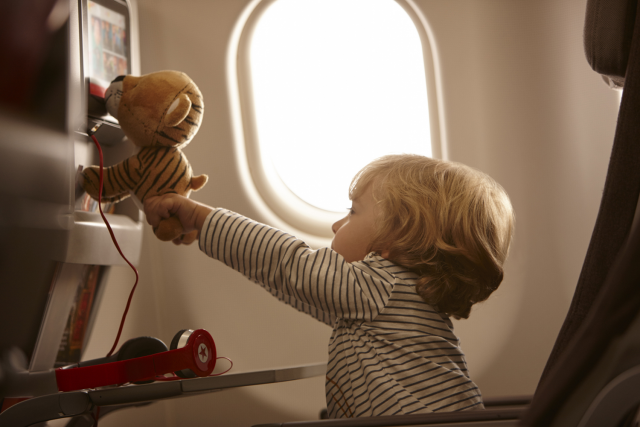
Parents with babies or little kids are often nervous at the prospect of flying with them for the first time. But steady your nerves and read my practical suggestions here, and you’ll come through with flying colours – and maybe even enjoy the trip!
Now, of course it’s not the same flying with an infant as with an older child. But one goal is in common for both: that as much as possible they travel safely and comfortably (indeed, that’s true for all of us). But some special considerations come to bear for the very youngest airline passengers.
Flying With Babies
Papers, please! Remember that flying with a minor in tow means having current documentation on hand – a passport for the child (or if you’re a European travelling within the European Union, a national identity card). Seems like a no-brainer, but you’d be surprised at often parents can overlook this, especially when it comes to infants.
Inquire ahead as to whether you can carry your baby in your arms, or you’ll need to pay a percentage to reserve a separate seat for placing a baby seat. For long flights, most airlines also offer the option of a crib.
When it comes to their health and comfort, the cabin pressure especially during takeoffs and landings can be bothersome to babies, particularly with ear pain. That’s why you should have handy a feeding bottle or pacifier; chewing on these will help relieve pressure, just like gum for adults.
And as you know, when it comes to babies, certain urgent needs can arise at any moment, so you’ll want to make sure your hand luggage includes nappies, a change of clothes, and damp wipes.
Speaking of the unexpected, you’ll similarly want to bring along a basic first-aid kit, including a thermometre and children’s pain reliever. Airport security should not give you a hassle about this (though on occasion some have been known to ask parents to sample the meds they’re carrying).
And if they’re not newborns, bring a teething ring, a doll or stuffed toy, or maybe a book to help keep them entertained during the flight.
Flying With Small Children
As with babies, above, passport or identification is key. So, too, are the remedies for pain/discomfort due to cabin pressure. If your toddler still uses a pacifier, great; if not, gum is the way to go. And as with babies, the mum-and-dad toolkit should be sure to include wipes and a change of clothes.
Beyond that, at this age it’s not uncommon for little kids to get airsick – and especially if they get carsick, it’s likely they’ll face this issue when flying, as well. And the remedies are similar: have them look straight ahead; don’t let them get too warm; and administer anti-nausea medication before flying. Children’s aspirin or pain reliever, as well as a thermometre, are also a good idea.
Also, comfortable clothes are a must for all airline passengers, but especially young children, both for sitting in their seats (especially for longer flights) and above all for going to the loo, with clothing that’s easy to slip on and off.
And at this age, entertainment options are especially important. On long-haul flights, Iberia has an extensive range of seatback entertainment options including videos and music made specifically for kids. But apart from that, bring their favorite books and toys, as well as colouring books and/or paper and crayons for drawing.
Finally, much of the advice above can be applied to older children, as well. Also, keep in mind that they are considered adults when it comes to booking and paying for airline seats. In any case, rest assured that for Iberia the safety and comfort of their youngest passengers are among their top priorities!
More info here.

